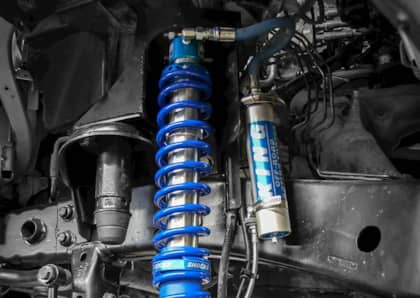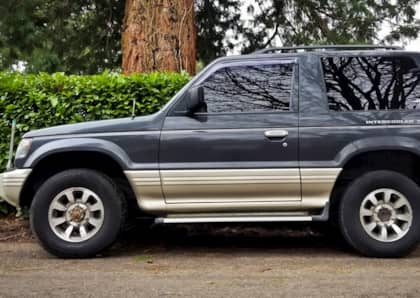Suspension Theory With King Shocks
Whenever you see a truck blast over an obstacle like it's nothing, you might wonder, “How in the heck did the truck survive?” The trick, besides skill and a dash of bravery, is in the suspension. And one of the most important parts of that suspension system are the shock absorbers.
We talked with Trevor Stark, one of the many talented engineers over at King Off-Road Racing Shocks to take a look at what makes an off-road shock unique and examine the different types.
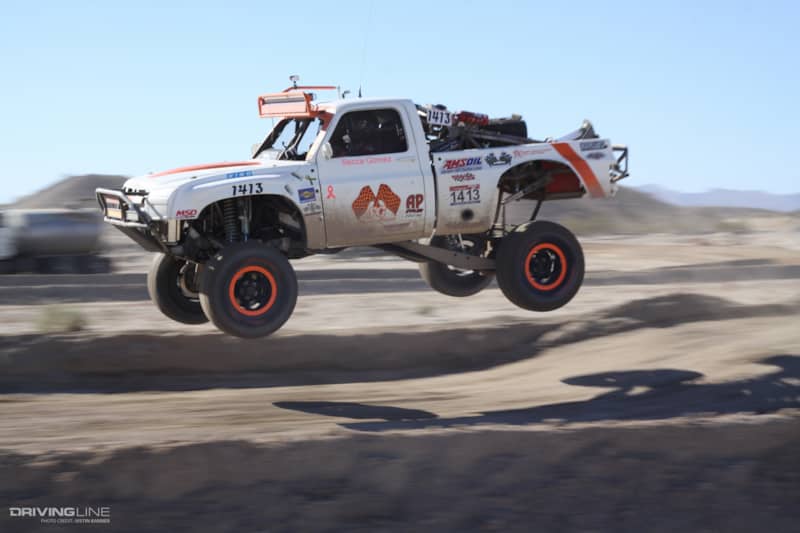
The idea of the shock is to slow and control wheel motion for ride comfort. This is true for both on-road and off, and the way it’s done isn’t that different, too. The core components of a conventional OE-replacement King shock include the following: the shock body, oil, nitrogen gas, a piston that separates the gas from the oil, the shock piston with holes and a flapper valving system on each side and the shock rod attached to that piston.
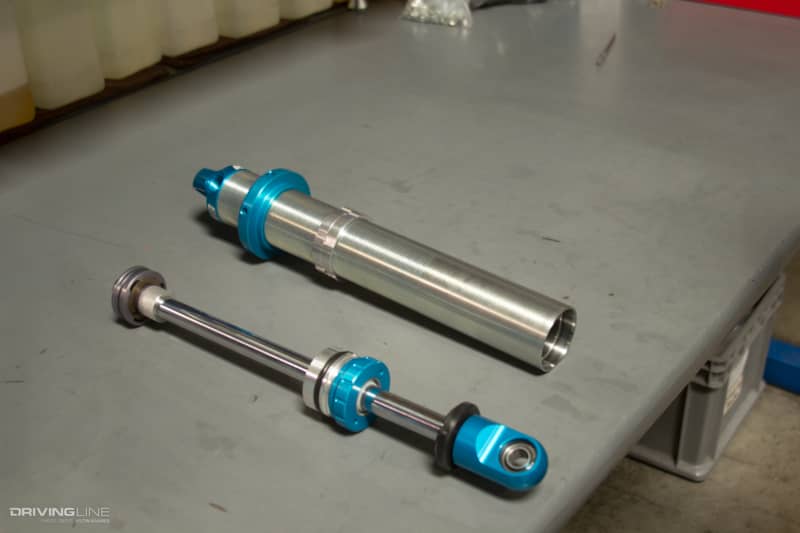
Nitrogen
The nitrogen gas is there to keep a consistent pressure on the shock oil. This helps prevent cavitation and aeration, which happen when shock oil essentially boils in the low pressure areas of the piston during compression and rebound, which releases gases into the oil. Nitrogen is used because it’s still compressible like air, but is more consistent when temperature changes. If you keep enough pressure on a fluid, you can prevent it from boiling and becoming a gas, much like how the water in your engine doesn’t boil because it’s under pressure. A majority of the time when you feel your non-pressurized shocks fade or act like there is a space of nothing, it's because of cavitation and aeration which makes the oil an inconsistent fluid. So the pressure from the nitrogen and dividing piston prevents the foaming you see happen in non-pressurized shocks.
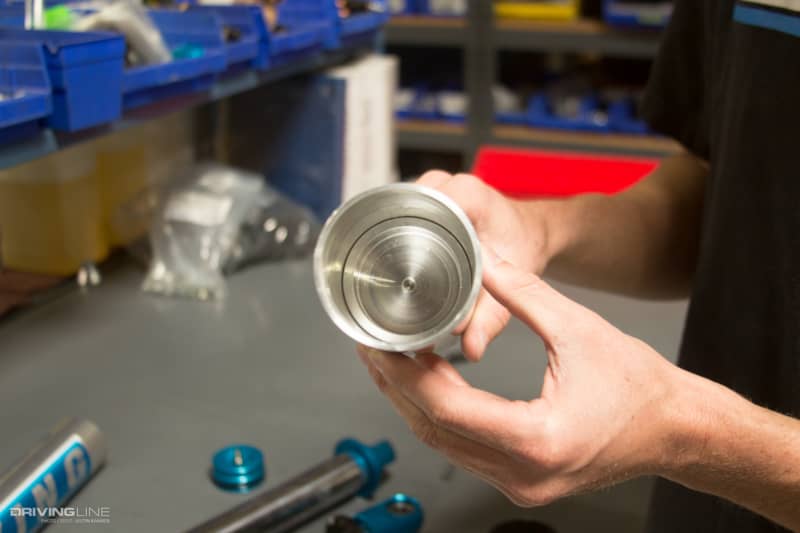
Pistons
Now, here is where things start to get different for corner carvers, street trucks and full off-road racing vehicles. The piston and valving design changes for each. Trevor explains what’s going on inside to help us understand:
“You have your working fluid inside the cylinder, and when your tire moves, it displaces the shock shaft, which then displaces the piston, and it moves through the fluid. To understand what’s happening, you should first imagine that there aren’t any holes in this piston and it’s solid. If you were to just have a solid piston and the shaft moves up the cylinder, you’re going to have a high pressure area above the piston and a low pressure area below it. The high-pressure fluid is going to want to find a way to the low pressure area by the path of least resistance, much like electricity. So when there are ports in this piston, the fluid is going to want to flow into those ports and into the low pressure area.”
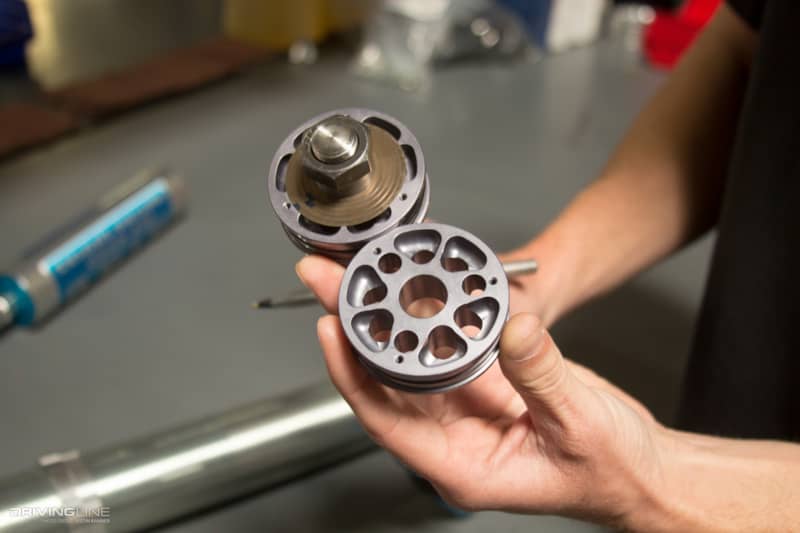
Bleed Holes
You probably noticed the small holes on the piston that are not covered by the valves. These are the free bleed holes that King purposely designed.
“The free bleed holes are there to control the chatter you get in some off-road shocks as they move the piston through the fluid,” says Trevor. “It helps smooth out some of the shutter you feel, like as you’re driving along a washboard road, controlling the spikes of movement you get in the hydraulic fluid and improving driving comfort. These holes are mainly effective at low speeds, which we define as 0 to 10 inches/second of shaft velocity.”
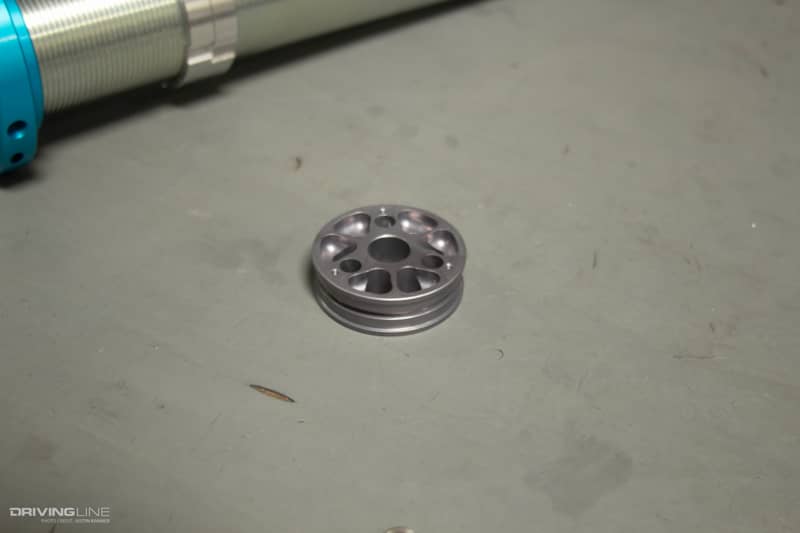
Other shock companies may define low speed differently, by the way, but 0 to 10 inches/second is what King considers “low-speed movement.” This is typically where you have gradual movements – like body roll as you corner, brake or accelerate. Hitting a curb, boulder or large pothole is considered a high-speed movement. So sudden movements that the shock encounters (even in the same direction it travels in) is “high-speed.”
"If you’re traveling down the highway in your truck," explains Trevor, "say a 2015 Ford F-150, and you encounter some rough patches in the pavement, you may see 40 inches/second in shaft velocity in the front shocks; that’s how fast your shock shaft is moving up and down. This isn’t as constant as another truck of a different suspension design. A 2000 Jeep Cherokee with solid axles front and rear may see a different velocity at that same point in the road. It will have a one-to-one movement with the rest of the suspension because it’s directly connected to the axle and wheel, whereas the F-150 will have a different motion ratio because of where it’s attached to the control arms.”
Valve Stack
Of course, you do still want to control all of the movement of the piston through the shock fluid, and that’s where the valving washer stack comes in.
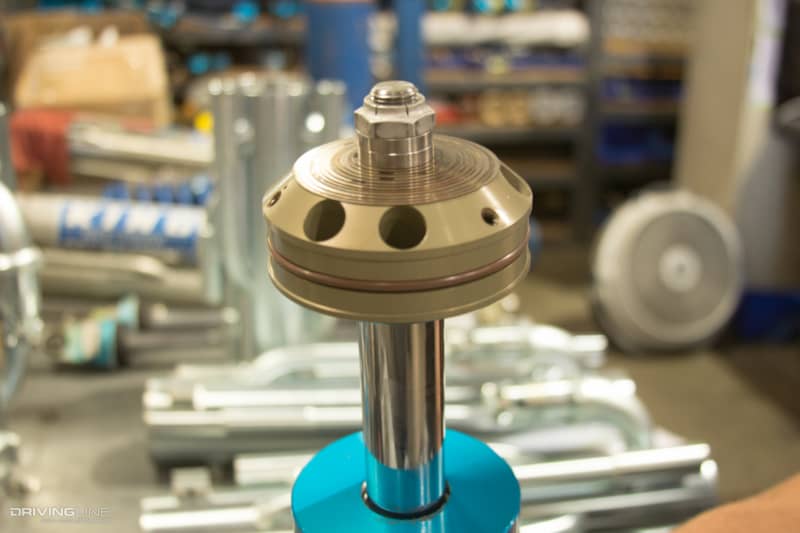
“So you have your piston moving through the fluid and the fluid moving though the ports,” continues Trevor. “On the exit of the ports there are valve washer stacks. Let’s say we’re going through compression, when the shock piston is going inside the cylinder – the high-pressure will flow into this pocket around the rebound washer stack to the low-pressure side and its washer stack. The shock fluid has to force open these washers to flow to the low-pressure side; mechanically, it works as a check valve.”
Since it’s about controlling the high-pressure getting to the low-pressure, that’s why the valving for compression is on the bottom of the piston rather than on top, and vice versa for rebound.
Street vs. Off-Road
So what makes an on-road shock different from an off-road one? Trevor says it all comes down to piston velocity.
“The street shock will typically see shaft velocities of up to 40 inches/second. Your UTV or tube-chassis race truck may have a shaft velocity of 50 to 65 inches/second. A Trophy Truck going through the whoops at 100 mph can be as high as 300 inches/second. When it comes to making a shock work for a particular vehicle, the shaft velocity is the most important thing to look at.
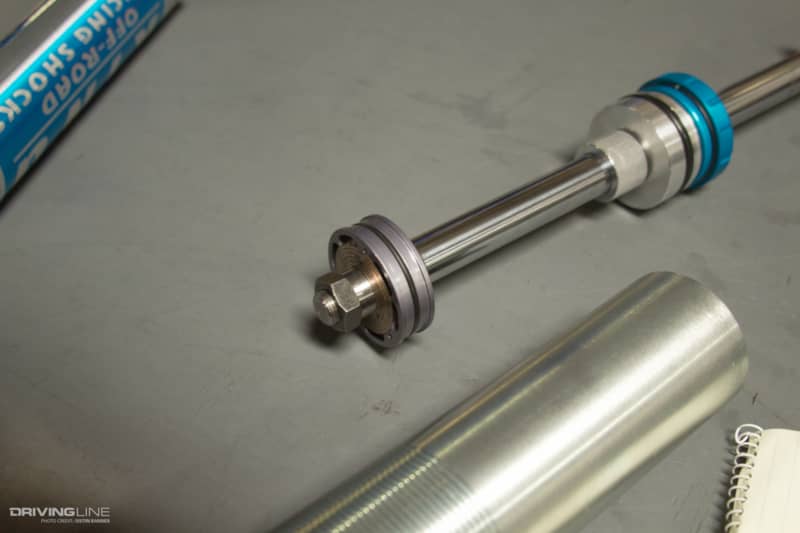
“If we’re looking at a street truck and we’re trying to optimize it for the street,” he continues, “we’re not going to tune that shock for anything above 50 inches/second. That’s out of the limits the vehicle is going to see, so you can create an optimal dampening curve based on the valve configuration and even make it non-linear valving. This means that the valving stack will not have a pyramid shape, so you can make it so that at 50 inches/second, it suddenly ramps up the force required to open the stack. If you did the same thing for another vehicle for a lower velocity, it may not like it, and the ride comfort would be lost. With us, we tune a street vehicle for lower shaft speeds, and we’ll concentrate more on free bleed because you’ll feel more of the chatter while driving as you go around corners and such. A race truck in the desert isn’t going to see u-turns, but a street vehicle will. A desert race vehicle, if in a u-turn, is pedal to the floor and sideways. So when it's a street shock on our shock dyno, we’re focused on a different spectrum than an off-road race shock.”
Spring Rates
Other factors in shocks, such as coilovers, are the springs and spring rates. Most coilover shocks have a primary (upper coil) and secondary (lower coil). If you had two 500-lbs/inch springs that worked with each other as a dual rate, the equivalent rate of both springs as they are being compressed is 250-lbs/inch. If you had two springs of different rates, like a 250-lb/inch and a 400-lb/inch, it’s then about 130-lb/inch and lower than the softer spring. With a King coilover, there is a physical stop called a coil nut which the coil slider – a composite, sliding perch that positions both springs on the shock body – will encounter and stop the movement of the upper spring. This then forces the suspension to ride on the lower, bigger rate spring. The coil nuts are also adjustable to the threaded body of the shock.
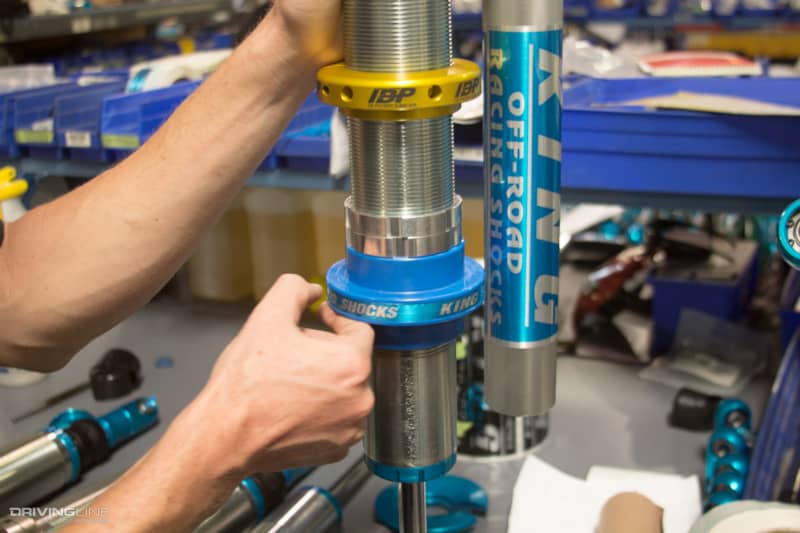
“This means that when you hit that coil nut," clarifies Trevor, "you immediately ramp up your spring rate to the larger one. So in our example, you'll be at that 130-lb/inch rate, the coil slider will hit the coil nut and then you’re at the 400-lb/inch spring rate.”
Shaft Size
While a piston has a lot to do with the shaft velocity, the shaft's diameter also comes into play.
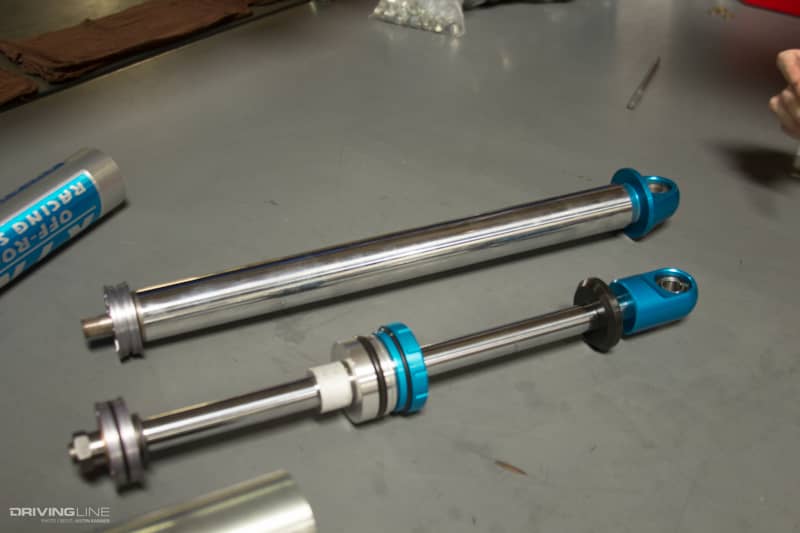
“The larger shaft here is 1 5/8 inches in diameter," says Trevor. "The smaller shaft is what we typically use in our 2.5 Pre-Runner shocks and it's 7/8 inch in diameter. The larger diameter shock shaft will generate a larger spring force and is the major difference between a regular shock and our air shocks and bumpstops. An air shock and bumpstop work on the same fundamentals – as your shaft is being compressed into your cylinder, the volume will change drastically generating a spring force.” That volume difference is also the reason you see reservoirs on many King shocks.
Hose Length
Speaking of reservoirs, hose length can also play a role in the shock’s performance. If the distance is too long, the hose between the reservoir and body can actually have enough fluid to make up the difference and, if not made of a heat transferring material (which most aren’t), it won’t remove the heat from the shock fluid.
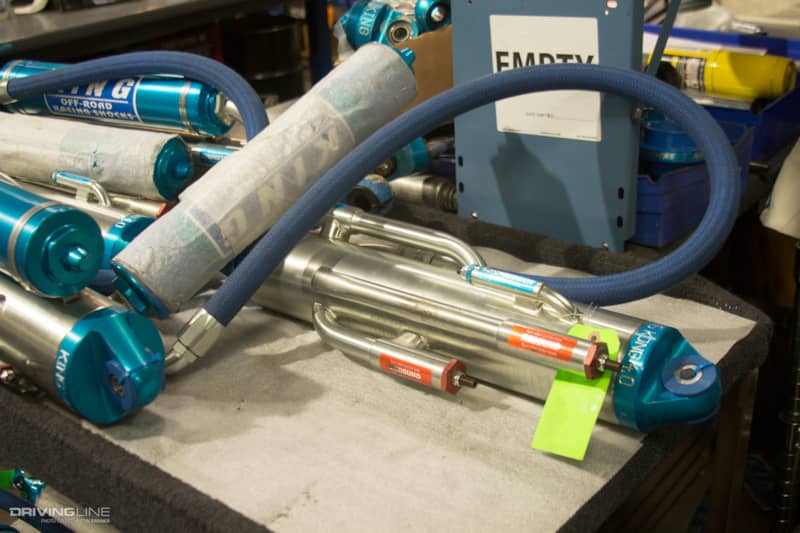
Basically, if a King engineer tells you that your hose between the shock and reservoir is too long, you might want to listen to them.
Air Bumps and Air Shocks
So how does an Air Bump Stop or Air Shock work differently compared to a standard shock? It goes back to the spring force we mentioned earlier:
“Spring force comes from having a large diameter shock shaft that displaces into a cylinder of fixed volume," Trevor points out. "If you take the initial gas volume, relate that to the volume of your shaft and compress the shaft into the cylinder, it will compress the gas proportionally that’s in the chamber. As you compress gas, you’re going to generate a force, which is spring force. That will physically hold ride height depending on vehicle weight and shock design. If you take a regular shock without a spring, it will just sink to the ground because it’s not designed to generate a force, but fight velocity changes by using dampening force. An air shock combines spring force and dampening force.”
A regular shock does generate some spring force, but as Trevor mentions, “That spring force may only be about 80 lbs. That 80 lbs. is not going to hold up your truck.”
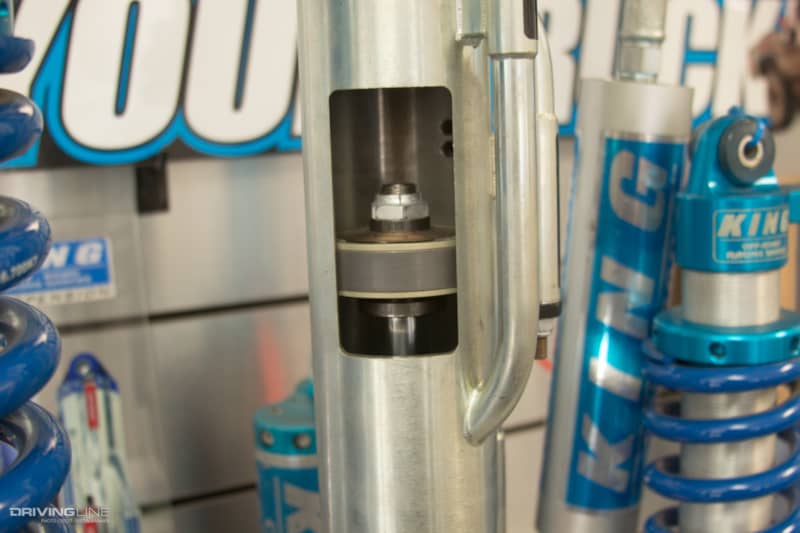
An Air Bump Stop has a very small gas chamber. If you look at the chamber above its piston and compare it to the volume of the chamber where the shaft resides, the change is far more dramatic than in an Air Shock and especially so compared to a standard shock absorber.
“On our Air Bump Stop, the volume change between the top of the piston and the shaft side of the piston is five times," states Trevor, "so from full extension it will compress the gas five times its original size. We do this for bottoming control so you don’t jolt your suspension to a stop – it’s gradual – and that improves ride comfort going to full bottom and saves suspension components as well.”
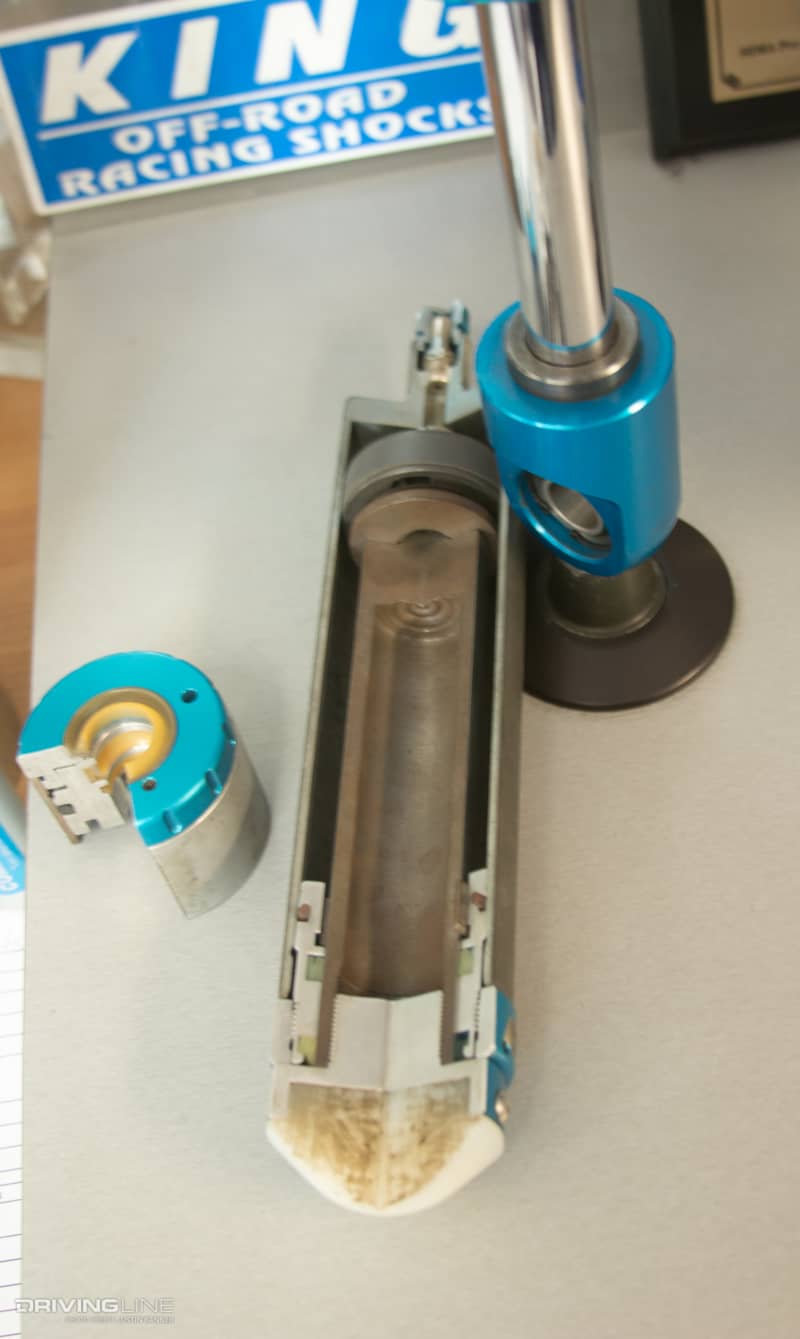
Bypass Shocks
Now the moment you've all been waiting for: the bypass shock. The main difference between the standard shock we’ve had as an example so far and the bypass shock comes down to this: while a standard shock is a linear viscous damper, the bypass is a non-linear viscous damper.
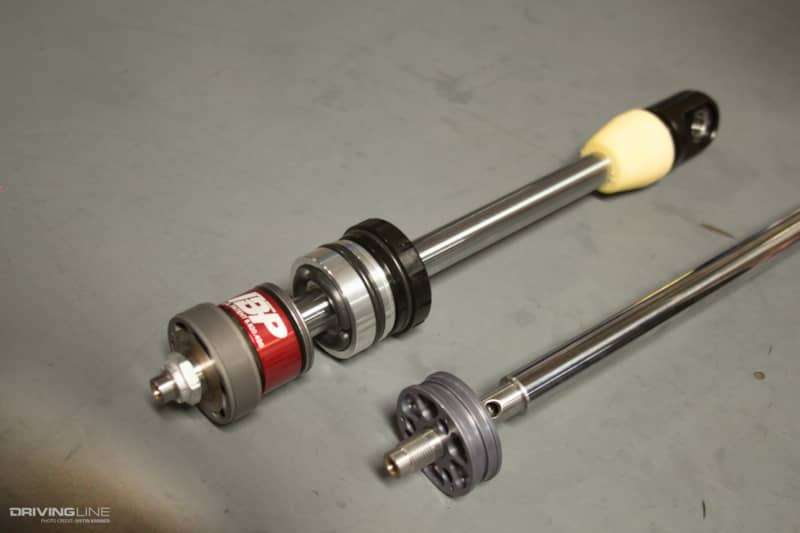
The difference goes further from the previous non-linear shock we had described as well. Where that previous example changed the characteristics by shock shaft speed and valving, the bypass is position dependent. The piston is still the same with a linear valve shim setup on the piston along with openings and channels in the piston like the linear shock, but at a certain point, or even at multiple points of shock shaft travel, the damping curve will change.
The first we’ll look at is actually a more recent design by King Shocks called the IBP, which stands for Internal Bypass.
Internal Bypass
Just like a standard shock, the piston contains channels and cutouts for the shock fluid to pass by and flow through valving. However, in the compression side of the piston, the shock shaft has a hollow stem that leads to a channel below the piston to the IBP’s secondary piston that sits below the primary one. This secondary piston contains valve washers like the primary, but is designed to allow the shock shaft to move at a certain rate it was designed for. Upon reaching the last several inches of travel, the needle closes off the path for the shock fluid that bypassed the primary piston, which now takes over.
“The fluid can physically pass through this channel and out this bottom hole," explains Trevor. The high pressure fluid can bypass the primary piston since it "assumes" there is no passage way because it’s looking for the path of least resistance.
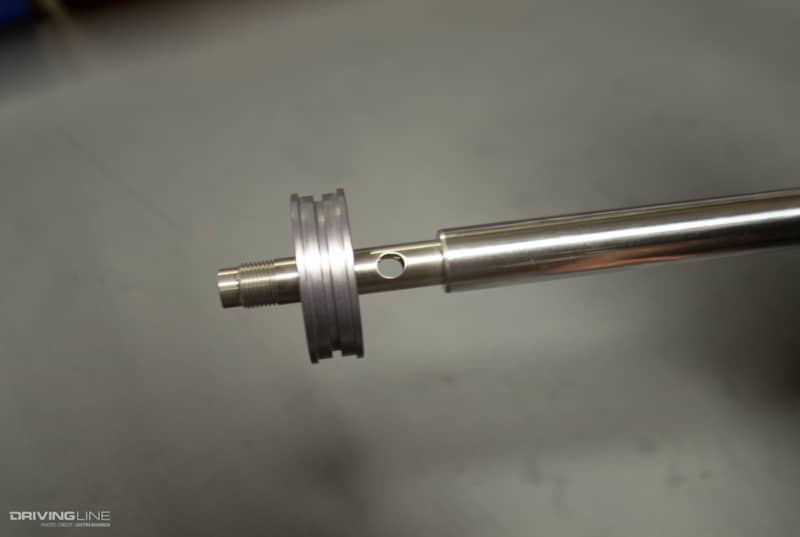
Closed Path
“When your suspension hits a large object and causes the shaft to displace all the way up the cylinder, it then hits this geometric constraint, the needle," continues Trevor. "The bleed is now closed and the path of least resistance has now closed. It’s now operating on the primary piston. Now, if we didn’t have this secondary piston – if that hole just remained open – the shock wouldn’t generate any dampening until it reached the top half of the stroke and closed off that channel.”
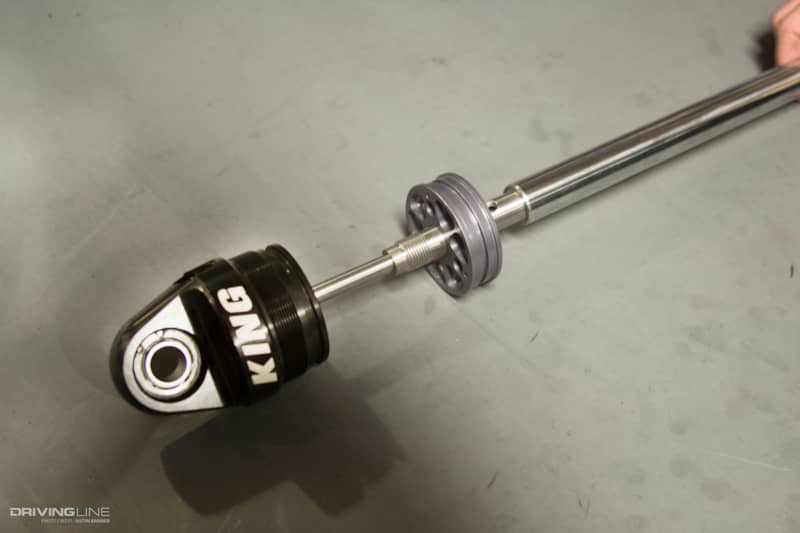
The secondary piston has channels and valves for both compression and rebound, just like the primary piston. The reason for this is to keep the shock from rebounding too quickly, causing the vehicle to bounce. As the shock continues through rebound the fluid is allowed to flow through both the primary and secondary valving. Once past the needle, fluid is able to move through both sets of valving shims and returns to normal dampening. The way the main piston is setup is that there are stiffer valve washers on the main piston for both compression and rebound for more force, but there are softer valve washers on the secondary piston because it’s operating about 70 to 75 percent of the time. The last 25 to 30 percent is done by the primary piston at or near full bump.
“The main advantage of the IBP,” says Trevor, “is that you get a position dependent feature that can vary the dampening coefficient of the shock absorber without the need of external tubes like a traditional bypass shock. When you vary the dampening coefficient of the shock absorber, you are going from a linear viscous shock absorber to non-linear shock absorber that is position dependent and velocity dependent.”
Needle Taper
So why have a taper on the needle? Wouldn’t a blunt or square shape work just as well?
No, it would actually be far too harsh, Trevor explains, “The needle shape allows the damper to roll into the primary valving; it’s smoother. If the end was blunt or square, you would have a real tough transition into the bump zone, and it would be harsh on the vehicle. It would feel like you’re bottoming out, but it’s just that harsh transition, and the taper prevents this.”
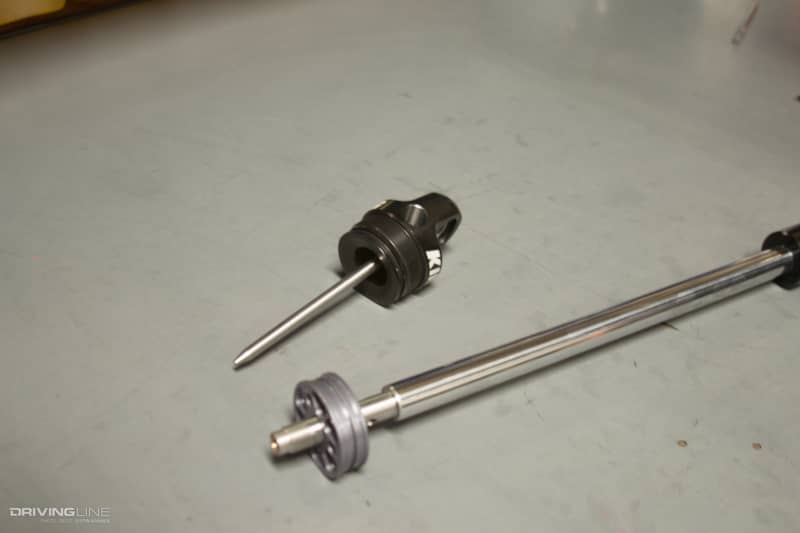
That last bit of travel, that 25 to 30 percent, is where damage to driver and truck can happen, which iss the main advantage of this style of non-linear absorption. With the ability to ramp up the force needed to compress and then rebound, the suspension in that range prevents harsh bottoming out and protects the driver and chassis from race-ending – or even career-ending – forces. The IBP shock is able to do that in a single package.
External Bypass
However, if you need position dependent control over several different positions of shaft travel in both directions of full travel, then you’re probably looking at a traditional bypass shock, like this King 4.5 Bypass damper.
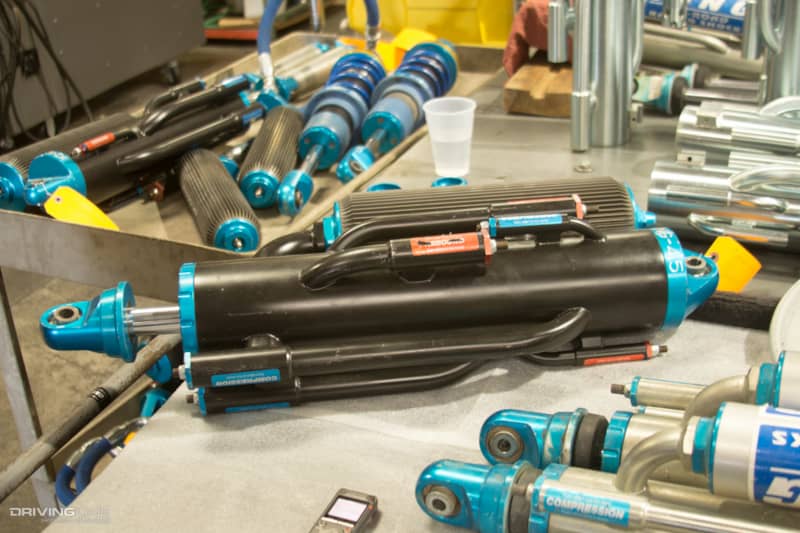
Most would assume that it would be a piston that doesn’t offer anything in terms of valving, but you’d be mistaken. It’s still a damper that uses a linear valving stack just like the smaller shocks and coilovers. The key difference is that it uses external tubes in several different spots within the travel of the shock shaft and piston to tune the performance precisely.
“Everything is still the same, just scaled up for this cylinder,” says Trevor. “We have a much larger piston. Now we also have dampening control being done from shock fluid going through just the passages and valves in the piston of a standard shock, to a channel inside the shaft to a secondary piston on the IBP, and now to a set of tubes welded to the cylinder. We still have a high pressure zone and a low pressure zone, but now the high-pressure fluid can pass through these tubes on the side of the cylinder.”
Tubes
Inside those tubes are another set of valves, but instead of washer valves, these are machined pistons that rest on the larger section of the bypass tubes. When the fluid flows into the bypass tube, that high pressure begins to push against that piston, which is held shut by a spring until the fluid pressure overcomes the spring’s pressure to open it up and allows fluid to flow into the tube.
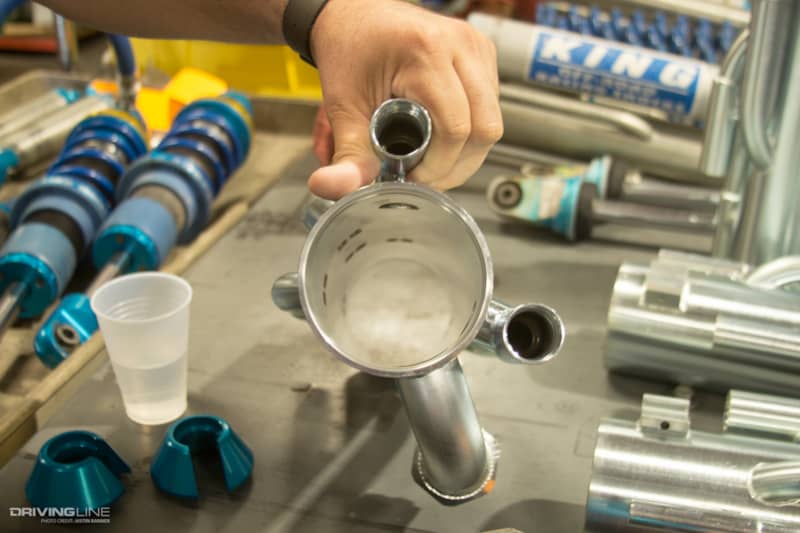
“When there is a minimum pressure pushing on the piston," says Trevor, "it can compress that spring, opening up and allowing the fluid to enter the low pressure area behind the piston. When the piston is moving the other way, the fluid then flows to the back side of the bypass tube valve and closes it, preventing that bypass tube from acting on the opposite direction of travel it is intended to work in.”
Limits
To make a bypass shock position dependent, the tubes are welded to the cylinder at different heights and the tubes are also different lengths to create different zones.
“You can modify the dampening coefficient within the range of each tube,” explains Trevor, “you can also change it by adjusting the valve adjuster on each tube. So you can change the adjustment, and it will only affect the dampening in the zone of the tube; this applies to every tube in each direction, both compression and rebound. We have a long tube, medium tube and short tube as well, in which you will adjust each zone to how you like it one by one.”
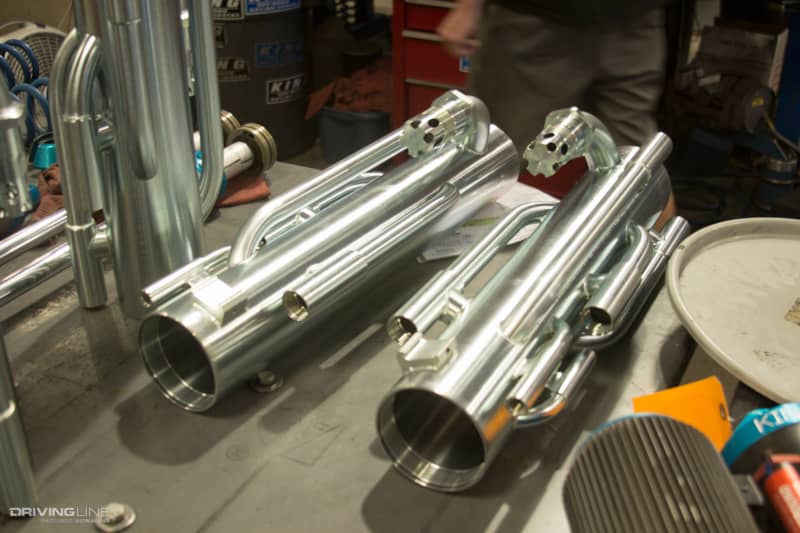
You can also have as many tubes as you want, but there is a limit before you encounter diminishing returns.
“Normally, seven is the limit on the amount of tubes you can run effectively,” Trevor points out. “We do have guys running eight and nine tube bypass shocks, but you don’t really feel the difference after seven. That’s really the maximum amount you can run that will work. Now, if you’re running a longer cylinder, you can have more zones that are spaced out more effectively, but running more bypass tubes won’t solve the lack of zone space.”
Adjusters
The bypass tube valve is adjustable by the allen screw after loosening the lock nut. The principal is the same as adjusting your coilover for preload. When you turn the allen in, you compress the spring that seats the valve, requiring more force to open it. Turning it out will produce the opposite effect. On top of that, King offers springs of different rates for the bypass valves for even further adjustments. A bypass shock is a custom tailored suspension part by the full definition. While the tubes you see here are as they are for this bypass, different customers will have different requests, and King designs each one to specification the customer requests.
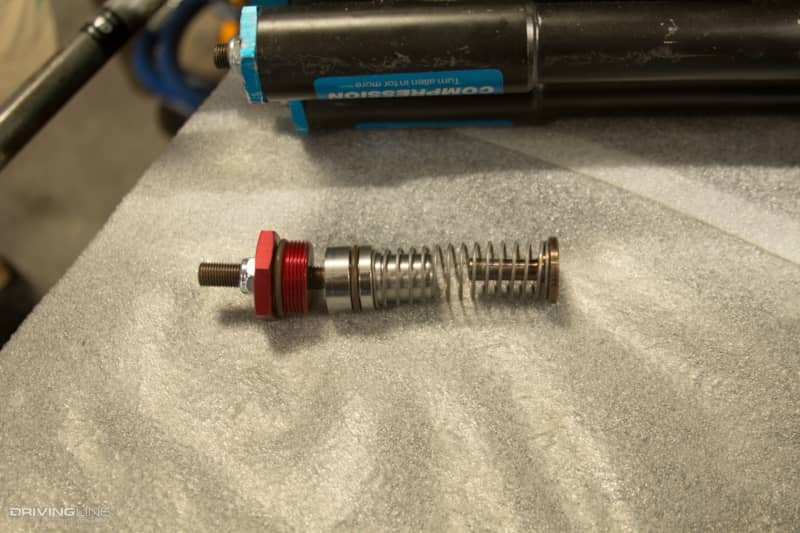
The More Shocks the Better?
So why run a bypass tube and a coilover with a linear viscous damper or even an IBP at the same time? Wouldn’t that be overkill? Well, not really.
“You still get your velocity sensitivity from your standard shock, but you are able to regulate the dampening coefficient during shaft travel with the external bypass," Trevor points out. "So instead of ramping up dampening force at the upper limit of travel like with the IBP, you can gradually ramp up that force before that upper zone, and you can also better regulate it in both directions in the same way with an external.”
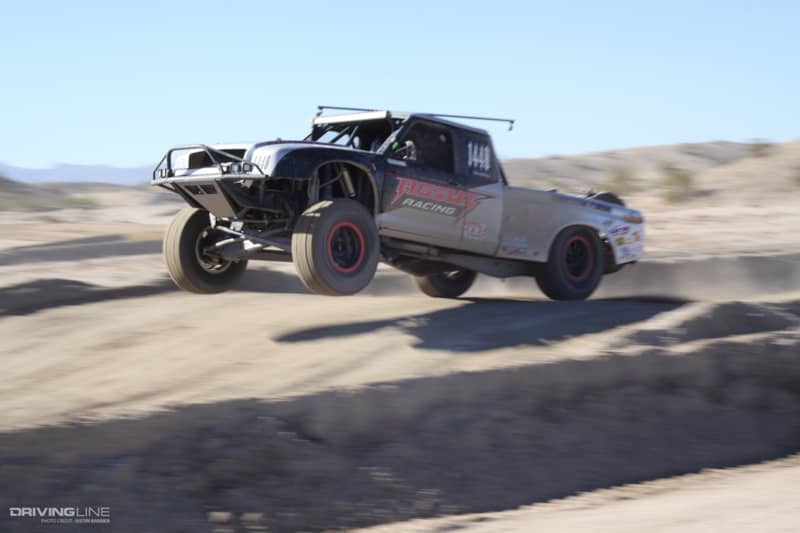
When you look at the suspension of your vehicle, both on-road and off-, it seems like it has a simple job: to control the motion of the wheel and body. However, as you can now see, that job isn’t as simple as it sounds. While the off-road shock and bypass are unique to the world of dirt and rocks, the way they work is no different from the world of pavement. The shock piston still must move through a fluid to control the motion of the wheels and body. The rates at which they are done are what separate them.
While you may have thought that a bypass was mostly for show or purely off-road, it has more advantages if you have the ability to use them. However, if you don’t, King has the Internal ByPass shock to cover you and give you the position dampening control you need at the last several inches of suspension travel. In short, if you have a vehicle that needs a shock, King has the right one you need, or they'll make it if they don’t have it on the shelf.




